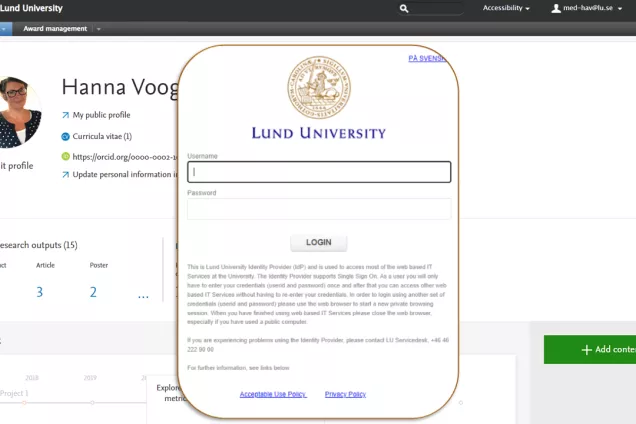Lucat administrators
The information on this page is aimed at Lucat administrators at Lund University. You will find information regarding how your work affects LUCRIS.
Your work in Lucat is important
Since LUCRIS imports parts of its basic data from Lucat, it is you as the Lucat administrator who lays the foundation for LUCRIS. All employees, organisations, and affiliations (connections between people and different organisations) are retrieved from Lucat. Anyone who has a so called 'verksamhetsroll' in Lucat can log in to LUCRIS.
How you contribute
As an administrator in Lucat, you contribute to the work in LUCRIS by keeping the information in Lucat accurate and up-to-date. This entails significant responsibility since certain changes, such as organisational restructuring, can create substantial extra work for others working in LUCRIS. By keeping the information in Lucat updated, the synchronized information into LUCRIS is also accurate. The synchronization occurs every night.
- For organisation administrators in Swedish (it.lu.se)
- For katalogue administrators in Swedish (it.lu.se)
Organisations
You have a major responsibility when it comes to Lucat's organisational structure ‘verksamhetsorganisation’ . Every night, the organisational structure (excluding the attestation organisation) is synchronized into LUCRIS. Changes in this structure in Lucat can, therefore, result in significant changes in LUCRIS as well.
You also update the organisations in LUCRIS when, for example, you add a description to a unit or create a new research group in the tree in Lucat. In short, all changes you make in the organisational structure are reflected in LUCRIS.
The information about the organisations retrieved from Lucat includes:
- Organisation's name (in Swedish and English)
- Organisation's position in the organisational tree
- Description (max 1024 characters due to Lucat's limitation)
- Research description (max 1024 characters due to Lucat's limitation)
- Website
- Website (eng)
- The organisation type
All the information above is also shown on the public graphical interface called the Research Portal.
Here we describe what happens in LUCRIS when you manage ‘verksamhetsorganisationen’ in Lucat. When an organisation:
- Is entered in Lucat for the first time, an organisational record including a start date is created in LUCRIS.
- Is moved in the organisation tree, it also moves in LUCRIS.
- Is shut down or removed from Lucat, the organisation becomes inactive in LUCRIS and is hidden from the Research Portal but remains in LUCRIS.
Organisational Restructuring
We, in the LUCRIS administration, appreciate being involved when significant changes that affect the organisation are planned, such as when something is moved or removed. This is to ensure that the changes are implemented correctly and do not result in additional work. Some changes cannot be undone once they are made.
Below are several scenarios of changes in the organisational structure that may be relevant to you:
If the organisation is to change its name, you change the name in Lucat. This is not an organisational reorganisation but only a name change. This change means that all information associated with the organisation in LUCRIS (such as individuals, publications, and projects) remains the same. The old name disappears, and all history is linked to the new name.
This is the easiest and least complicated change. If you create an entirely new organisation and connect individuals in Lucat, the organisation will appear in LUCRIS and the Research Portal the next day. Note that the organisation will be empty of any previous work done by researchers. No publications, projects, or similar will be associated with the new organisation. This is preferable since the organisation is new and no research has been conducted under it before. It may be beneficial to collaborate with your local communicator and us at LUCRIS when adding a new organisation. This way, we can collectively review whether the organisation's page in the Research Portal should have any specific image, text, or tagging of, for example, UN sustainability goals and UKÄ classification.
If an organisation is to change its location within the organisational structure, it is important to make the move in Lucat. If you move the organisation within the tree in Lucat, the change occurs in the same way in LUCRIS without the need for additional work. If, instead, you create a new organisation with the same name, it will be empty of content such as publications and projects in LUCRIS. This is not recommended. It would require a lot of work to transfer content from the older version to the new organisation with the same name.
If the organisational change involves the end of a unit that is entirely absorbed by another unit, we make this change in LUCRIS. You should then contact support and explain which organisation should be "taken over" by another. There are two options:
- The disppearing organisation remains in the system (taken over by).
This is used, for example, when an organisation has been significant, and one wants to be able to extract statistics about it even later. - The disppearing organisation disappears entirely (merge).
This is used, for example, if there was an error in Lucat, and the organisation should never have been synchronized into LUCRIS in the first place. Please note that once the merger is done in LUCRIS, the change cannot be undone. Therefore, it is essential to carefully consider what needs to be done and involve the LUCRIS administration in the change.
This organisational restructuring involves an organisation remaining in LUCRIS with its name and parts of the content it is associated with, while a breakaway organisation takes certain content currently tied to the already existing organisation. To achieve this, an administrator in Lucat must create a new organisation in the right place in the organisational tree. Subsequently, someone with high LUCRIS authority must manually transfer the right content from the old to the new organisation. This is a time-consuming change.
This is the most challenging organisational restructuring. To achieve this change, an administrator in Lucat must first create two new organisations in the right place in the organisational structure. Then, someone with high LUCRIS authority must manually transfer the right content to the correct organisation. This is highly time-consuming and should only be done if necessary.
Persons
It is the personal information in Lucat that determines whether a person can log in to LUCRIS, making it particularly crucial. When a person is initially added to Lucat, certain information is synchronized into LUCRIS the following day. This information remains in LUCRIS even if the person leaves Lund University. Therefore, a returning person benefits from having the same Lucat ID as before.
The information synchronized from Lucat includes:
- Name
- Position (job title from Primula)
- Organisational roles ('Verksamhetsroller' in Swedish)
- Affiliations
- ORCID-ID (if added to Lucat through passport.lu.se)
- Contact information (email address and telephone number)
- Link from a personal website (if applicable)
The information above is also visible on the Research Portal if no steps have been taken to hide certain information from the web in Lucat.
The organisational roles are particularly important
It is usually you that researchers turn to when they cannot log in to LUCRIS. The most common reason is that they do not have any ‘verksamhetsroll’ and need to be assigned one in order to be able to log in with their Lucat ID. Once you've added a role, the person can log in the next day.
About the profile's visibility in the Research Portal
A person can have a hidden or visible profile in LUCRIS which decides whether the profile is shown in the Research Portal. The visibility can be changed in LUCRIS.
When someone appears for the first time in Lucat and the data is transferred into LUCRIS, the visibility is automatically set based on their ‘verksamhetsroll’ .
Certain roles that are guaranteed to contain research such as "Professor" or "Researcher" are made visible in the Research portal when synced into LUCRIS. Others, such as administrators, have an invisible profile in the Research Portal. After the person is read in for the first time, the visibility can be changed in LUCRIS.
FAQ for Lucat and LUCRIS
No, the authorization to post images in LUCRIS is usually only held by one person at each faculty and it usually does not lie with the Lucat administrators. Contact support to find out who can help with that.
As Lucat's administrator, you do not need to do anything in LUCRIS when a researcher leaves Lund University. The person's user in LUCRIS is deleted automatically, but the person itself and the data about the person remain. Then we who have high administrative rights in LUCRIS hide the profile from the Research Portal after about a month.
No, it is not possible to add infrastructures in LUCRIS trough Lucat. There is an organisation type in Lucat called 'infrastrukturenhet' (infrastructure unit). These unit types are synchronized as organisations in LUCRIS.
The infrastructures in LUCRIS belong to a specific infrastructure registry and are directly added into LUCRIS by the LUCRIS administration.
Contact the LUCRIS support
E-mail: servicedesk [at] lu [dot] se
Phone: 046-222 90 00
Monday - Friday 8:00-17:00
Web form: support.lu.se

Log in to LUCRIS
(lucris.lub.lu.se)

Research portal
(portal.research.lu.se)

